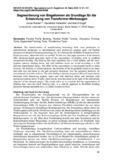Citation link:
http://dx.doi.org/10.25819/ubsi/10398Files in This Item:
| File | Description | Size | Format | |
|---|---|---|---|---|
| Reuter_Segmentierung_von_Biegeformen.pdf | 1.84 MB | Adobe PDF |  View/Open |
| Dokument Type: | InProceedings | metadata.dc.title: | Segmentierung von Biegeformen als Grundlage für die Entwicklung von Transformer-Werkzeugen | Authors: | Reuter, Jonas Aslanidis, Apostolos Engel, Bernd |
Institute: | Institut für Produktionstechnik | Free keywords: | Flexible Profile Bending, Flexible Profile Forming, Adjustable Forming Tools, Segmented Forming Tools, Transformer Tools | Dewey Decimal Classification: | 620 Ingenieurwissenschaften und zugeordnete Tätigkeiten | GHBS-Clases: | ZIR | Issue Date: | 2023 | Publish Date: | 2023 | Source: | Engel, Bernd (Hrsg.): Transformation in der Biegetechnik : Tagungsband zum 6. Biegeforum Siegen : 24.-31. März 2023. Siegen: universi - Universitätsverlag Siegen, 2023. - ISBN 978-3-96182-155-6 - DOI http://dx.doi.org/10.25819/ubsi/10365, S. 91-101 | Abstract: | The transformation of manufacturing technology from mass production to individualized production or individualized mass production requires agile and flexible processes on the part of forming technology. To overcome the flexibility limitations of toolbound processes, adjustable tools are needed. To this end, this paper presents a finite element (FE) simulation-based parameter study of the segmentation of bending tools in modified compression bending. The bending dies were segmented into a fixed number, and the intersegment spacing, bending factor, and wall thickness factor are varied according to a full factorial experimental design. The effect of the segmentation is investigated based on strain contours, the histories of contact pressure, the histories of the longitudinal strains at the inner and outer arcs and based on the part geometry deviations from the geometry produced by conventional closed die surfaces. The main finding is that the (negative) effect of segmentation decreases with decreasing segment space and wall thickness factor and increases with increasing bending factor. Finally, these results were discussed in the light of the subordinate objective of the research project. The results allow us to conclude that the segmentation of bending dies, even for small bending radii, is a suitable approach to flexibilize bending processes through adjustable tools, so called transformer tools. |
DOI: | http://dx.doi.org/10.25819/ubsi/10398 | URN: | urn:nbn:de:hbz:467-26104 | URI: | https://dspace.ub.uni-siegen.de/handle/ubsi/2610 | License: | http://creativecommons.org/licenses/by-sa/4.0/ |
| Appears in Collections: | Universi |
This item is protected by original copyright |
Page view(s)
250
checked on Dec 2, 2024
Download(s)
66
checked on Dec 2, 2024
Google ScholarTM
Check
Altmetric
This item is licensed under a Creative Commons License


